Abstract
The present study describes the isolation of the novel strain Candida intermedia CBS 141442 and investigates the potential of this microorganism for the conversion of lignocellulosic streams. Different C. intermedia clones were isolated during an adaptive laboratory evolution experiment under the selection pressure of lignocellulosic hydrolysate and in strong competition with industrial, xylose-fermenting Saccharomyces cerevisiae cells. Isolates showed different but stable colony and cell morphologies when growing in a solid agar medium (smooth, intermediate and complex morphology) and liquid medium (unicellular, aggregates and pseudohyphal morphology). Clones of the same morphology showed similar fermentation patterns, and the C. intermedia clone I5 (CBS 141442) was selected for further testing due to its superior capacity for xylose consumption (90% of the initial xylose concentration within 72 h) and the highest ethanol yields (0.25 ± 0.02 g ethanol/g sugars consumed). Compared to the well-known yeast Scheffersomyces stipitis, the selected strain showed slightly higher tolerance to the lignocellulosic-derived inhibitors when fermenting a wheat straw hydrolysate. Furthermore, its higher glucose consumption rates (compared to S. stipitis) and its capacity for glucose and xylose co-fermentation makes C. intermedia CBS 141442 an attractive microorganism for the conversion of lignocellulosic substrates, as demonstrated in simultaneous saccharification and fermentation processes.
1. Introduction
Bioethanol is currently the most widely used liquid biofuel. In 2017, the total global bioethanol production was 85 billion L [1], most of which was made from conventional feedstocks such as corn, grain or sugarcane. However, these sugar- and starch-rich feedstocks are expensive and their use competes with the food and feed sector. Lignocellulosic biomass offers a cheap and attractive alternative due to its availability, a high carbohydrate content (up to 75% of the total dry weight), and the lack of competition with the food and feed sector [2]. However, the production of lignocellulosic bioethanol is still low, as it is characterized by high costs and low yields resulting from its complex composition (30–50% cellulose, 10–40% hemicellulose and 5–30% lignin) and the recalcitrant nature of lignocellulose [2]. Thus, substantial technological development is needed to increase the economic competitiveness of this process.
The conversion of lignocellulosic biomass to ethanol is a multistep process involving pretreatment, enzymatic hydrolysis and fermentation, followed by product purification. The goals of the physical and chemical pretreatment are: (i) to break down the lignin, (ii) to solubilize the hemicellulose to produce monomeric sugars, (iii) to disrupt the crystalline structure of the biomass and (iv) to minimize formation of furans, phenolic compounds and weak carboxylic acids that severely inhibit subsequent processing [3,4]. The disrupted cellulose fibers are then hydrolyzed to glucose using a cocktail of cellulolytic enzymes, and, finally, microorganisms are used to ferment the monomeric sugars to ethanol. Instead of sequential, separate hydrolysis and fermentation (SHF), these steps can be combined in a single reactor and carried out as simultaneous saccharification and fermentation (SSF). In SSF, the glucose released by the hydrolyzing enzymes is immediately consumed by the fermenting microorganism. This keeps the concentration of glucose low in the medium, which reduces the problem of end-product inhibition of cellulases, and increases overall yields, making SSF an often preferred choice over SHF [5,6].
Glucose and xylose are the major monosaccharides in lignocellulosic hydrolysates originating from hardwood and annual plants, and complete fermentation of both components is key to achieving a high overall yield of ethanol. Most fermentative microorganisms utilize glucose before xylose due to glucose repression and the higher affinities for glucose than xylose of their sugar uptake systems [7,8]. The competitive inhibition of sugar uptake is also the main reason why recombinant Saccharomyces cerevisiae strains show inefficient fermentation of xylose in the presence of high concentrations of glucose, despite constitutive expression of heterologous genes encoding xylose metabolic enzymes [9]. This is unfortunate, as simultaneous cofermentation of the two monosaccharides can substantially shorten the fermentation time. Moreover, microbes are generally more affected by inhibitors and stressors in the xylose-consumption phase, leading to cessation of fermentation, and cofermentation can help alleviate this problem [10]. Therefore, robust yeast species with cofermentation capacity are highly sought-after for industrial use.
The xylose-fermenting yeast species Candida intermedia has several industrially relevant traits, including high specific growth rates in xylose-containing media and well characterized transporters for both high-capacity, low-affinity glucose/xylose diffusion and high-affinity glucose/xylose-proton symport [11,12,13]. In this work, we describe the isolation and characterization of 18 C. intermedia clones exhibiting three different cell morphologies from a coculture of S. cerevisiae growing in a medium containing lignocellulosic hydrolysate. One of the clones, C. intermedia strain CBS 141442, was selected and its fermentation performance under different process configuration strategies was investigated and compared to that of the xylose-fermenting yeast Scheffersomyces stipitis. The results presented demonstrate the potential of C. intermedia as a glucose/xylose cofermentative microorganism for bioethanol production from lignocellulosic feedstocks.
2. Materials and Methods
2.1. Microorganisms and Media Composition
C. intermedia was isolated as a contaminant from adaptive laboratory evolution (ALE) cultures of an industrial xylose-fermenting S. cerevisiae strain. Cells were grown for more than 400 generations in repetitive batch cultivation in a medium containing xylose as the main carbon source and increasing concentrations of lignocellulosic hydrolysate. To obtain individual clones, cells from the ALE experiment were grown as single colonies on agar plates with 20 g/L xylose as a carbon source and 20% (v/v) lignocellulosic hydrolysate. The selected clones were identified by PCR amplification and sequencing of the internal transcribed spacer (ITS) regions and the D1/D2 region of the large-subunit RNA gene, as described previously [14,15]. C. intermedia clone I5 was selected for further characterization and deposited in the CBS database at the Westerdijk Fungal Biodiversity Institute as C. intermedia CBS 141442. S. stipitis CBS 6054 was used as a reference xylose- and glucose-fermenting strain [16].
The microorganisms were propagated in synthetic medium with the following composition: 10 g/L glucose, 20 g/L xylose, 7.5 g/L (NH4)2SO4, 3.5 g/L KH2PO4, 0.75 g/L MgSO4·7H2O, 2 mL/L trace metal solution and 1 mL/L vitamin solution (20 g/L agar was added to obtain a solid medium) [17].
The liquid fraction from acid-catalyzed steam-exploded wheat straw was collected by vacuum filtration of the pretreated material and used as lignocellulosic hydrolysate in this study. This pretreatment was performed at SEKAB E Technology (Örnsköldsvik, Sweden) under conditions similar to those reported as “severe” by Nielsen et al. [18] (i.e., to facilitate biomass accessibility, but also resulting in high concentrations of inhibitory products). The chemical composition of the lignocellulosic hydrolysate was analyzed as described below, and was found to have the following composition: 14.5 g/L glucose, 32.6 g/L xylose, 8.5 g/L acetic acid, 1.6 g/L formic acid, 7.4 g/L furfural and 1.3 g/L 5-hydroxymetylfurfural (5-HMF). For clone isolation and fermentation assays, the lignocellulosic hydrolysate was diluted to 20–50% (v/v), supplemented with glucose (5–10 g/L), xylose (15–30 g/L) and (NH4)2PO4 (0.5 g/L), and the pH adjusted to 5.5 with 10 M NaOH. To obtain a solid growth medium when appropriate, 20 g/L agar was added. The hydrolysate was filter-sterilized (0.22 µm) and stored at 4 °C prior to use.
2.2. Fermentation of the Lignocellulosic Hydrolysate
To obtain yeast biomass for the fermentation assays, 100–300 µL cell suspension frozen in 20% (v/v) glycerol was used to inoculate 100 mL synthetic medium in 500 mL baffled flaks, and cultivated at 30 °C with stirring at 150 rpm for 16–18 h. To preadapt cells for the inhibitory lignocellulosic hydrolysate prior to fermentation, the growth medium was then supplemented with non-diluted lignocellulosic hydrolysate to a final concentration of 15% (v/v) [19]. After a total cultivation time of 24 h, cells were collected by centrifugation at 5000× g for 5 min and washed once with distilled water before being added to the fermentation medium.
Fermentation assays were performed in duplicate or triplicate in 100 mL shake flasks containing 30 mL 20–50% (v/v) lignocellulosic hydrolysate. After inoculation with 3 g/L cell dry weight (CDW) yeast, the flasks were incubated at 30 °C with stirring at 150 rpm for 72 h. Fermentation assays were performed with an airlock system that allows CO2 outflow and prevents O2 inflow, to maintain low oxygen concentrations, as this triggers ethanol production in the Crabtree-negative yeasts C. intermedia and S. stipitis [10,20,21].
2.3. Batch and Fed-Batch Fermentation in Synthetic Medium
Batch and fed-batch fermentations were performed with C. intermedia CBS 141442 and S. stipitis CBS 6054 in synthetic medium. Fermentations were carried out in duplicate or triplicate under well-controlled conditions, in 1 L DASGIP Bioreactors (Juelich, Germany) containing an initial working volume of 400 mL. The fermentation conditions were as follows: an initial cell concentration of 0.25 CDW g/L, 30 °C, pH 5.5 (2 M KOH), 2 mL of a 2% (v/v) antifoam solution (Antifoam 204; Sigma Aldrich, USA), constant stirring (300 rpm) and no aeration. The fermentation performance was assessed by simulating the amounts of glucose and xylose present in different configurations commonly used for lignocellulose bioethanol production [22]:
- (a)
- Batch SHF: initial addition of 10 g/L glucose and 20 g/L xylose with no additional feeding (Figure 1a).
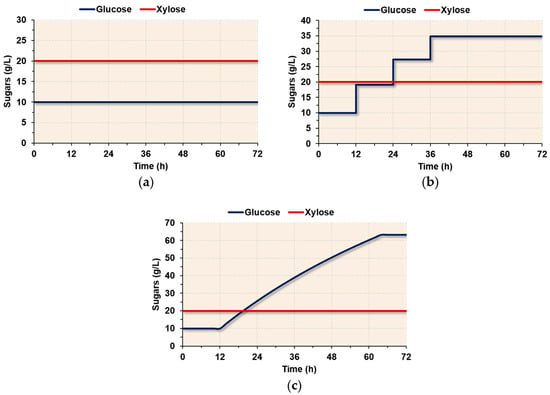 Figure 1. Simulation of sugars present during lignocellulose bioethanol production with different configurations. Illustrations of the glucose and xylose concentrations as a function of time during: (a) batch sequential, separate hydrolysis and fermentation (SHF) fermentation, (b) SHF + fed-batch simultaneous saccharification and fermentation (SSF) fermentation and (c) SSF fermentation. It should be noted that the actual sugar concentration in the reactor depends on the extent of microbial conversion in each case (not simulated here).
Figure 1. Simulation of sugars present during lignocellulose bioethanol production with different configurations. Illustrations of the glucose and xylose concentrations as a function of time during: (a) batch sequential, separate hydrolysis and fermentation (SHF) fermentation, (b) SHF + fed-batch simultaneous saccharification and fermentation (SSF) fermentation and (c) SSF fermentation. It should be noted that the actual sugar concentration in the reactor depends on the extent of microbial conversion in each case (not simulated here). - (b)
- SHF + fed-batch SSF: initial addition of 10 g/L glucose and 20 g/L xylose and supply of additional glucose and xylose (to avoid the dilution of xylose as the volume increased) during the fermentation process by the addition of 20 mL synthetic medium containing 200 g/L glucose and 20 g/L xylose at 12 h, 24 h and 36 h (Figure 1b).
- (c)
- SSF: initial addition of 10 g/L glucose and 20 g/L xylose and additional supply of glucose and xylose (to avoid the dilution of xylose as the volume increased) during the fermentation process by the continuous feeding of synthetic medium containing 200 g/L glucose and 20 g/L xylose from 12 to 60 h of fermentation at a flow rate of 3 mL/h (Figure 1c).
Please note that no solid substrate was used—the SSF assays were simulated by addition of external glucose and xylose as explained above.
2.4. Analytical Methods
The concentrations of glucose, xylose, xylitol, glycerol, acetate, ethanol, 5-HMF and furfural were determined using a Dionex high-performance liquid chromatograph (Thermo Fisher Scientific, USA) equipped with a Rezex ROA-organic acid H+ column (Phenomenex, USA) at 80 °C, and using 5 mM H2SO4 (0.8 mL/min) as the mobile phase. Metabolites were identified using a Dionex RI-101 refractive index detector (Thermo Fisher Scientific, USA) operating at 35 °C and a Dionex UltiMate™ 3000 VWD UV detector (Thermo Fisher Scientific, USA) measuring at a fixed wavelength (210 nm).
Images of the cells were obtained by optical microscopy at 100× magnification without cell dying, using a Leica DM 2000 light microscope (Leica Microsystems, Germany). Biomass concentration in terms of CDW was determined during bioreactor assays by filtering a known sampling volume through 0.45 µm polyethersulfone filters (Sartorius Stedim, Aubagne, France), dried in a microwave oven (10 min, 500 W) and then weighed on a balance with a sensitivity of 0.1 mg.
Analysis of variance (ANOVA) with Bonferroni’s post-test was used for comparisons of different fermentation parameters using the software Statgraphics Centurion XVII. The level of significance was set at p < 0.05.
3. Results
3.1. Isolation of C. intermedia Clone I5
C. intermedia was found as a contaminant in an ALE experiment in which an industrial xylose-fermenting strain of S. cerevisiae was being evolved for improved xylose utilization capacity in the presence of lignocellulosic inhibitors (Figure 2a). After completion of the ALE experiment, cells were plated for single colonies on solid synthetic medium containing xylose and 20% (v/v) wheat straw hydrolysate. Individual colonies with three different morphologies were identified, hereafter referred to as smooth, intermediate and complex (Figure 2b). Sequencing of the ITS and D1/D2 genomic regions of the individual clones revealed that the small, smooth colonies visible on the plate were S. cerevisiae, whereas the larger smooth, intermediate and complex colonies were all of C. intermedia origin. C. intermedia was also found in several populations sampled throughout the ALE experiment, which underlines the capacity of C. intermedia to grow under these challenging conditions and in strong competition with S. cerevisiae.
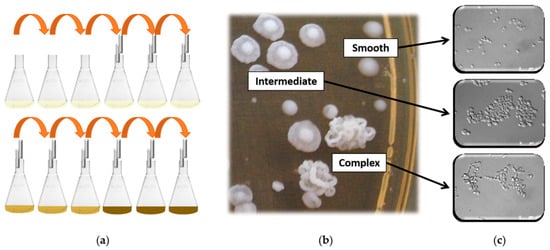
Figure 2.
Isolation and morphological characterization of C. intermedia. (a) Simplified scheme of the adaptive laboratory evolution setup from which C. intermedia clones were isolated. Different colonies and cell morphologies of a mixed, xylose-growing population, in (b) solid and (c) liquid media. Clones were isolated at 30 °C from plates with synthetic medium supplemented with 20% (v/v) wheat straw hydrolysate. Selected colonies were grown in a synthetic liquid medium (without lignocellulosic hydrolysate) at 30 °C for 24 h. The images were obtained by optical microscopy at 100× magnification.
Representative C. intermedia colonies of each morphology were grown in liquid synthetic medium and microscopically examined to determine their cell morphologies and growth patterns. Cells from colonies with smooth morphology divided as individual, budding yeasts, whereas cells from colonies with intermediate morphology grew as aggregates in the liquid media (Figure 2c). Finally, cells from colonies with complex morphology grew in the form of pseudohyphae. These results demonstrate the ability of C. intermedia to propagate in different forms, which also influences the colony morphologies of this yeast species.
3.2. Characterization of C. intermedia Isolates
To determine the potential of C. intermedia for lignocellulosic bioethanol production, we assessed the fermentation performance of individual clones in the presence of inhibitory compounds. Five to seven C. intermedia clones of each morphology were used to ferment 20% (v/v) lignocellulose hydrolysate. In general, isolated clones with a similar colony morphology showed comparable fermentation performance in terms of ethanol yield, percentage of xylose consumed and xylitol yield (Table 1). The highest ethanol yields (0.22–0.30 g/g) were obtained with the clones showing complex colony morphology. However, these cells were more difficult to cultivate (poor biomass formation) and harvest (problematic to centrifuge) compared to yeast-shaped cells. As these traits severely limit the usefulness in biotechnological applications, these clones were not further investigated. Clones originating from smooth and intermediate colonies showed similar ethanol yields, ranging from 0.17 to 0.24 g/g and 0.16 to 0.25 g/g, respectively. However, higher xylose consumption was observed using the clones with intermediate colony morphology (49–95% of the xylose consumed within 72 h) than by the smooth clones (59–67%). Among the intermediate clones tested, clone I5, hereafter referred to as C. intermedia CBS 141442, showed the highest ethanol yield (0.25 ± 0.02 g/g) and a very high xylose consumption capacity (91%), and was therefore selected for further studies.

Table 1.
Ethanol yield, percentage of xylose consumed and xylitol yield obtained after 72 h of fermentation of 20% (v/v) wheat straw hydrolysate with different isolated C. intermedia clones.
3.3. Fermentation Performance of C. intermedia CBS 141,442 in Wheat Straw Hydrolysate
In order to evaluate the tolerance of C. intermedia strain CBS 141442 to lignocellulosic inhibitors, fermentations were carried out with increasing concentrations of lignocellulosic hydrolysate. Fermentation assays with the yeast S. stipitis CBS 6054 were run in parallel for comparison, as the xylose-fermenting capacity of this strain has been studied extensively [16,23,24,25]. Both C. intermedia and S. stipitis could ferment a 40% (v/v) lignocellulosic hydrolysate (Figure 3a,b and Table 2). Under these conditions, C. intermedia performed better than S. stipitis in terms of xylose consumption. C. intermedia consumed 4.5 times more xylose than S. stipitis (42.4% vs. 9.4%), which also benefitted the overall fermentation process, increasing the final ethanol concentration 1.6-fold (5.9 ± 0.2 g/L vs. 3.6 ± 0.7 g/L). Furthermore, although glucose exhaustion was observed within 72 h for both yeast strains, only C. intermedia was capable of cofermenting glucose and xylose in this challenging environment. However, a concentration of 50% (v/v) lignocellulosic hydrolysate resulted in complete fermentation inhibition after 12 h for C. intermedia CBS 141442 (Figure 3d), and immediately after inoculation for S. stipitis CB S6054 (Figure 3d).
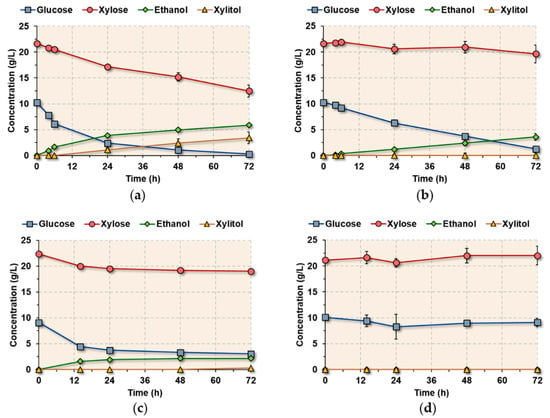
Figure 3.
Time course of batch fermentation of wheat straw hydrolysate. Fermentation with (a,b) 40% (v/v) and (c,d) 50% (v/v) wheat straw hydrolysate, using (a,c) C. intermedia CBS 141442 and (b,d) S. stipitis CB 6054 as fermentative microorganisms. Values were calculated from three independent cultivations and the error bars indicate the standard deviations.

Table 2.
Results of fermentation in terms of ethanol yield, xylose consumed and xylitol yield.
3.4. Fermentation Performance of C. intermedia CBS 141442 under Different Fermentation Strategies
The fermentation performance of C. intermedia was also compared with S. stipitis in the absence of inhibitory compounds for the most common process configurations used for the fermentation of lignocellulosic materials: batch SHF, SHF + fed-batch SSF and SSF (Figure 1) [22]. In the batch SHF fermentation mode, C. intermedia and S. stipitis exhibited similar fermentation profiles in terms of glucose and xylose consumption, showing higher glucose uptake rates (0.8 ± 0.1 g/L h and 0.4 ± 0.0 g/L h) than xylose uptake rates (0.1 ± 0.0 g/L h and 0.2 ± 0.0 g/L h; Figure 4). Both C. intermedia and S. stipitis were thus capable of glucose and xylose cofermentation under these conditions. This suggests that C. intermedia and S. stipitis can coutilize glucose and xylose without influencing xylose metabolism when the glucose concentration is low. A similar pattern was observed during the fermentation of 40% (v/v) hydrolysate, where the same glucose/xylose ratios were used (Figure 3). However, lower sugar consumption rates were observed when fermenting the wheat straw hydrolysate, probably due to the presence of inhibitory compounds.
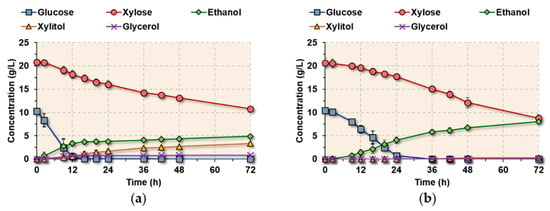
Figure 4.
Time course of batch fermentation of synthetic medium. Assays were performed using (a) C. intermedia CBS 141442 and (b) S. stipitis CBS 6054 as fermentative microorganisms. No glucose or xylose was added during the fermentation process. Values were calculated from two independent cultivations and the error bars indicate the minimum and maximum values.
In the SHF + fed-batch SSF mode, C. intermedia exhibited better fermentation performance in terms of sugar consumption and ethanol production than S. stipitis (Figure 5, Table 2). This can be explained by the 2-fold higher glucose consumption rate (0.8 g/L h vs. 0.4 g/L h) observed for C. intermedia in the absence of inhibitors, which contributes to maintaining low glucose levels after each feeding stage, and facilitates glucose and xylose coconsumption. When using S. stipitis, on the other hand, glucose accumulated over time, which probably limited xylose conversion.
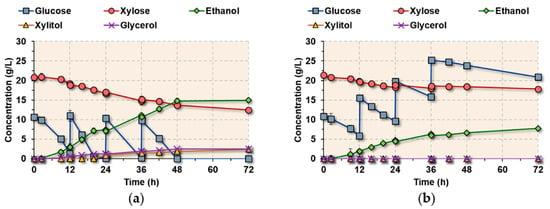
Figure 5.
Time course of batch fermentation of synthetic medium in the SHF + fed-batch SSF mode. Assays were performed with (a) C. intermedia CBS 141442 and (b) S. stipitis CBS 6054 as fermentative microorganisms. Of the synthetic medium 20 mL containing 200 g/L glucose and 20 g/L xylose was added 12 h, 24 h and 36 h after inoculation. Values were calculated from two independent cultivations and the error bars indicate the minimum and maximum values.
Similar results to the SHF + fed-batch SSF were also observed for the SSF fermentations (Figure 6, Table 2). C. intermedia cells were capable of coconsuming glucose and xylose to produce ethanol (and xylitol and glycerol as byproducts), while fermentation with S. stipitis resulted in glucose accumulation during the feeding phase, hindering xylose assimilation by this yeast. When using C. intermedia as the fermentative microorganism, both SHF + fed-batch SSF and SSF fermentation strategies resulted in increased ethanol yields, compared to batch SHF (i.e., 0.31 ± 0.00 g/g and 0.34 ± 0.01 g/g vs. 0.24 ± 0.00 g/g in batch SHF; p < 0.05) and reduced xylitol yields (0.25 ± 0.01 g/g and 0.31 ± 0.02 g/g vs. 0.33 ± 0.01 g/g in batch SHF; p < 0.05 for SHF + fed-batch SSF, but no statistically differences were found for the xylitol yields during SSF fermentation strategy; Table 2). In spite of the differences found in other fermentation parameters, similar biomass concentration profiles were found for both C. intermedia and S. stipitis independent of the fermentation strategy (with a final biomass concentration of 3–4 g/L for batch; 5–6 g/L for SHF + fed-batch SSF and 6–7 g/L for SSF). These results also supported the hypothesis that lower glucose consumption rates are the main limitation during SHF + fed-batch SSF and SSF fermentations with S. stipitis, since lower concentrations of glucose and xylose were consumed by this yeast in comparison to C. intermedia despite having similar biomass concentrations (Figure 5 and Figure 6).
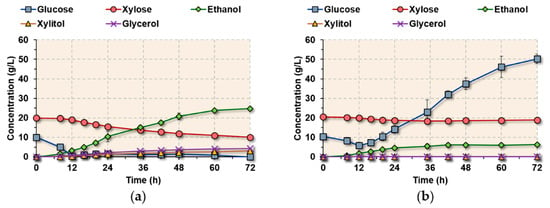
Figure 6.
Time course of the batch fermentation of synthetic medium simulating an SSF process. Assays were performed with (a) C. intermedia CBS 141442 and (b) S. stipitis CBS 6054 as fermentative microorganisms. Synthetic medium containing 200 g/L glucose and 20 g/L xylose was added continuously between 12 and 60 h of fermentation at a flow rate of 3 mL/h. Values were calculated from three independent cultivations and the error bars indicate the standard deviations.
These results reflect the generally good fermentation performance of C. intermedia under the strategies commonly used in the lignocellulosic industry, and the ability of its sugar uptake system to utilize different glucose/xylose mixtures during fermentation.
4. Discussion
To achieve cost-competitive production of lignocellulosic bioethanol, the fermenting microorganism must be able to efficiently convert glucose and xylose into ethanol in a highly challenging environment. Stressors such as lignocellulose-derived inhibitory compounds, initial high sugar concentrations and increasing concentrations of ethanol, exert negative effects on the fermentative microorganism. The selection and development of robust strains with a broad substrate range is therefore of the utmost importance to maximize final bioethanol titers and yields. In this study, we described the identification and characterization of the C. intermedia strain CBS 141442, isolated from a coculture with S. cerevisiae in an inhibitory lignocellulosic hydrolysate. This strain exhibited cofermentation of glucose and xylose, a trait that was more pronounced in SSF than in SHF. Glucose/xylose cofermentation is a highly desirable yet rare trait in microorganisms, which can lead to shorter fermentation times and higher overall yields than in sequential sugar utilization. C. intermedia thus has potential as a future cell factory and as a donor of genes and knowledge for strain development.
C. intermedia is one of the fastest xylose-utilizing yeast species characterized to date, and its specific growth rates on glucose and xylose are almost identical [11]. In the present study, we found that C. intermedia strain CBS 141442 was capable of cofermentation of glucose and xylose in SHF, although it consumes glucose at a higher rate than xylose in this fermentation setup. The SHF fermentation profiles reported here are very similar to those reported in several previous studies on C. intermedia [10,11,13,26]. A likely explanation of the higher glucose consumption rate observed is that extracellular glucose inhibits xylose uptake. Two of the glucose/xylose transporters in C. intermedia, Gxf1 and Gxs1, have been characterized previously. Gxf1 is a low-affinity, high-capacity glucose/xylose facilitator that is expressed at high concentrations (20–200 g/L) of both glucose and xylose, with about 25-fold higher affinity for glucose than xylose. The high-affinity low-capacity glucose/xylose symporter, Gxs1, is instead expressed at low xylose concentrations (<5 g/L) [12,13]. In the experimental strategies used in this study, Gxf1 is probably expressed, but may not be the only transporter acting. In a recent study, we identified several additional genes that encode putative transporters in C. intermedia, which may also mediate xylose uptake [13]. For example, we found a close homolog to GXF1, named GXF2, which is expressed during growth in both glucose and xylose-containing media and may also contribute to sugar uptake during fermentation. However, the activity and substrate affinities of both Gxf2 and the other novel transporters remain to be confirmed.
In contrast to SHF, where initial glucose concentrations are high, SSF strategies are characterized by low glucose concentrations since fermentative microorganisms consume the glucose as it is being released through hydrolysis. The low glucose concentrations in SSF might exert less inhibition on xylose uptake. This is in line with the steady xylose utilization observed for C. intermedia during SSF, independent of the glucose feeding profile. Although the genome sequence and the transcriptional profiles for growth in glucose and xylose are available [13], we still know very little about how this yeast regulates its sugar metabolism, and future studies are required to elucidate the glucose repression mechanisms, and to perform metabolic modeling and flux analysis in C. intermedia.
In the SHF strategy with lignocellulose-derived inhibitors, C. intermedia performed better than the S. stipitis strain CBS 6054. This may reflect the fact that the C. intermedia strain CBS 141442 was isolated from an ALE experiment, and has thus evolved to tolerate lignocellulosic inhibitors. However, S. stipitis produced more ethanol and less xylitol from xylose than C. intermedia, probably due to a better cofactor balance in the xylose assimilation pathway. The differences in cofactor utilization by xylose reductases (XR) that often prefers NADPH over NADH and xylitol dehydrogenases (XDH) using NAD+ leads to an incomplete cofactor recycling and a subsequent accumulation of xylitol, which ultimately results in lower product yields [27]. C. intermedia possesses no less than three different XRs, two with strict NADPH dependence and one with dual cofactor specificity [13]. The latter has the potential to relieve the cell’s cofactor imbalance [13], but this enzyme may not be sufficiently expressed under the conditions employed in this study. On the other hand, C. intermedia outcompetes S. stipitis in minimal medium under different SSF-like strategies, as S. stipitis exhibits slower glucose utilization. As a result, glucose accumulates in the fermentation medium, which may inhibit xylose uptake through transporters with higher affinities for glucose. Both species are Crabtree-negative yeasts that ferment only under oxygen-limited conditions, and the range of oxygen levels within which S. stipitis ferments is known to be limited [10,20,21]. In this context, oxygen levels in the fermentation assays might also contribute to the lower sugar uptake/conversion rates observed for S. stipitis.
In this work, the isolated C. intermedia strain CBS 141442 was able to compete with S. cerevisiae in lignocellulosic hydrolysate in the ALE experiment. C. intermedia may have prevailed in the coculture because of its superior capacity to utilize xylose, rather than a high inhibitor tolerance, as S. cerevisiae clones isolated from the same coculture outperformed C. intermedia in fermentations with high concentrations of lignocellulosic hydrolysate (unpublished results). Moreover, C. intermedia displayed different cell morphologies in the coculture, which were also stable when cells were transferred to the synthetic medium in the absence of lignocellulose-derived inhibitors. In fact, the intermediate morphology of CBS 141442 was noticeable throughout the whole study. It is an intriguing thought that the different cell types may reflect cells with specialized roles in the mixed population. We observed that cells with different morphologies had different fermentative capacities, but extensive physiological characterization would be required to confirm the connection between morphology and fermentation performance, which was outside the scope of this study. Nevertheless, morphological switching is a common trait among yeast species in response to environmental stimulus. Haploid strains of S. cerevisiae can exhibit invasive growth, whereas diploids show pseudohyphal growth in response to nitrogen starvation [28]. C. albicans, which is more closely related to C. intermedia than S. cerevisiae, shows filamentous growth in response to a variety of environmental conditions such as hypoxia, relatively high temperature, high CO2 concentrations and nutrient-poor conditions [29,30]. C. intermedia has previously exhibited a temporary morphological switch (from unicellular growth to pseudohyphal and back to unicellular growth) during an ALE experiment in the presence of a sublethal ethanol concentration (4% v/v) [10]. Despite the better cell robustness in adverse environments during pseudohyphal growth, yeast-shaped cells are often preferred in biotechnological processes as unicellular organisms are easier to cultivate and handle than filamentous microorganisms.
In summary, we identified and characterized several clones of C. intermedia that were isolated from an inhibitory lignocellulosic hydrolysate. The fermentation performance of one of these clones, C. intermedia strain CBS 141442, was either comparable or superior to that of the S. stipitis strain CBS 6054, depending on the design of the fermentation process. In particular, we showed that C. intermedia could coferment glucose and xylose, and that this trait was more pronounced in SSF than in SHF. These results highlighted the potential of C. intermedia CBS 141442 for use as a cell factory for the conversion of lignocellulose to ethanol. Characterization of natural glucose/xylose cofermenting yeasts can provide important insights into the physiology and genetics behind this much-sought-after trait, which will help in future strain development and the implementation of optimal lignocellulosic biomass conversion processes.
Author Contributions
Conceptualization, A.D.M., E.T.-P., L.O. and C.G.; investigation, A.D.M., E.T.-P. and C.G.; writing—original draft preparation, A.D.M. and C.G.; writing—reviewing and editing, A.D.M., E.T.-P., L.O. and C.G.; supervision, L.O.; funding acquisition, L.O. and C.G. All authors have read and agreed to the published version of the manuscript.
Funding
This work was financed by the Swedish Energy Agency (projects 35372-1 and 38779-1).
Acknowledgments
SEKAB E Technology is gratefully acknowledged for providing the pretreated material, and Cost Action Yeast4Bio (CA18229) supported by COST (European Cooperation in Science and Technology) for facilitating collaboration.
Conflicts of Interest
The authors declare no conflict of interest. The funders had no role in the design of the study; in the collection, analysis, or interpretation of data; in the writing of the manuscript, or in the decision to publish the results.
References
- Kummamuru, B. Global Bioenergy Statistics; World Bioenergy Association: Stockholm, Sweden, 2019; Available online: https://worldbioenergy.org/uploads/191129%20WBA%20GBS%202019_HQ.pdf (accessed on 1 September 2020).
- McKendry, P. Energy production from biomass (part 1): Overview of biomass. Bioresour. Technol. 2002, 83, 37–46. [Google Scholar] [CrossRef]
- Moreno, A.D.; Olsson, L. Pretreatment of lignocellulosic feedstocks. In Extremophilic Enzymatic Processing of Lignocellulosic Feedstocks to Bioenergy; Sani, R.K., Krishnaraj, R.N., Eds.; Springer International Publishing AG: Cham, Switzerland, 2017; pp. 31–52. [Google Scholar]
- Moreno, A.D.; Tomás-Pejó, E.; Ballesteros, M.; Negro, M.J. Pretreatment technologies for lignocellulosic biomass deconstruction within a biorefinery perspective. In Biofuels: Alternative Feedstocks and Conversion Processes for the Production of Liquid and Gaseous Biofuels, 2nd ed.; Pandey, A., Larroche, C., Dussap, C.-G., Gnansounou, E., Khanal, S.K., Ricke, S., Eds.; Academic Press: Cambridge, MA, USA, 2019; pp. 379–399. [Google Scholar]
- Alfani, F.; Gallifuoco, A.; Saporosi, A.; Spera, A.; Cantarella, M. Comparison of SHF and SSF processes for the bioconversion of steam-exploded wheat straw. J. Ind. Microbiol. Biotechnol. 2000, 25, 184–192. [Google Scholar] [CrossRef]
- Tomás-Pejó, E.; Oliva, J.M.; Ballesteros, M.; Olsson, L. Comparison of SHF and SSF processes from steam-exploded wheat straw for ethanol production by xylose-fermenting and robust glucose-fermenting Saccharomyces cerevisiae strains. Biotechnol. Bioeng. 2008, 100, 1122–1131. [Google Scholar] [CrossRef] [PubMed]
- Hou, J.; Qiu, C.; Shen, Y.; Li, H.; Bao, X. Engineering of Saccharomyces cerevisiae for the efficient co-utilization of glucose and xylose. FEMS Yeast Res. 2017, 17. [Google Scholar] [CrossRef] [PubMed]
- Gancedo, J.M. Yeast carbon catabolite repression. Microbiol. Mol. Biol. Rev. 1998, 62, 334–361. [Google Scholar] [CrossRef]
- Moyses, D.N.; Reis, V.C.; de Almeida, J.R.; de Moraes, L.M.; Torres, F.A. Xylose fermentation by Saccharomyces cerevisiae: Challenges and prospects. Int. J. Mol. Sci. 2016, 17, 207. [Google Scholar] [CrossRef]
- Moreno, A.D.; Carbone, A.; Pavone, R.; Olsson, L.; Geijer, C. Evolutionary engineered Candida intermedia exhibits improved xylose utilization and robustness to lignocellulose-derived inhibitors and ethanol. Appl. Microbiol. Biotechnol. 2019, 103, 1405–1416. [Google Scholar] [CrossRef]
- Gárdonyi, M.; Österberg, M.; Rodrigues, C.; Spencer-Martins, I.; Hahn-Hägerdal, B. High capacity xylose transport in Candida intermedia PYCC 4715. FEMS Yeast Res. 2003, 3, 45–52. [Google Scholar]
- Leandro, M.J.; Goncalves, P.; Spencer-Martins, I. Two glucose/xylose transporter genes from the yeast Candida intermedia: First molecular characterization of a yeast xylose-H+ symporter. Biochem. J. 2006, 395, 543–549. [Google Scholar] [CrossRef]
- Geijer, C.; Faria-Oliveira, F.; Moreno, A.D.; Stenberg, S.; Mazurkewich, S.; Olsson, L. Genomic and transcriptomic analysis of Candida intermedia reveals the genetic determinants for its xylose-converting capacity. Biotechnol. Biofuels 2020, 13, 48. [Google Scholar] [CrossRef]
- Kurtzman, C.P.; Robnett, C.J. Identification of clinically important ascomycetous yeasts based on nucleotide divergence in the 5’ end of the large-subunit (26S) ribosomal DNA gene. J. Clin. Microbiol. 1997, 35, 1216–1223. [Google Scholar] [CrossRef] [PubMed]
- Kurtzman, C.P.; Robnett, C.J. Identification and phylogeny of ascomycetous yeasts from analysis of nuclear large subunit (26S) ribosomal DNA partial sequences. Antonie Van Leeuwenhoek 1998, 73, 331–371. [Google Scholar] [CrossRef] [PubMed]
- Negro, M.J.; Álvarez, C.; Ballesteros, I.; Romero, I.; Ballesteros, M.; Castro, E.; Manzanares, P.; Moya, M.; Oliva, J.M. Ethanol production from glucose and xylose obtained from steam exploded water-extracted olive tree pruning using phosphoric acid as catalyst. Bioresour. Technol. 2014, 153, 101–107. [Google Scholar] [CrossRef]
- Verduyn, C.; Postma, E.; Scheffers, W.A.; van Dijken, J.P. Physiology of Saccharomyces cerevisiae in anaerobic glucose-limited chemostat cultures. J. Gen. Microbiol. 1990, 136, 395–403. [Google Scholar] [CrossRef]
- Nielsen, F.; Zacchi, G.; Galbe, M.; Wallberg, O. Prefermentation improves ethanol yield in separate hydrolysis and cofermentation of steam-pretreated wheat straw. Sustain. Chem. Process. 2016, 4, 10. [Google Scholar] [CrossRef]
- Nielsen, F.; Tomás-Pejó, E.; Olsson, L.; Wallberg, O. Short-term adaptation during propagation improves the performance of xylose-fermenting Saccharomyces cerevisiae in simultaneous saccharification and co-fermentation. Biotechnol. Biofuels 2015, 8, 219. [Google Scholar] [CrossRef] [PubMed]
- Su, Y.K.; Willis, L.B.; Jeffries, T.W. Effects of aeration on growth, ethanol and polyol accumulation by Spathaspora passalidarum NRRL Y-27907 and Scheffersomyces stipitis NRRL Y-7124. Biotechnol. Bioeng. 2015, 112, 457–469. [Google Scholar] [CrossRef] [PubMed]
- Skoog, K.; Hahn-Hägerdal, B. Effect of oxygenation on xylose fermentation by Pichia stipitis. Appl. Environ. Microbiol. 1990, 56, 3389–3394. [Google Scholar] [CrossRef]
- Cannella, D.; Jørgensen, H. Do new cellulolytic enzyme preparations affect the industrial strategies for high solids lignocellulosic ethanol production? Biotechnol. Bioeng. 2014, 111, 59–68. [Google Scholar] [CrossRef]
- Van Vleet, J.H.; Jeffries, T.W. Yeast metabolic engineering for hemicellulosic ethanol production. Curr. Opin. Biotechnol. 2009, 20, 300–306. [Google Scholar] [CrossRef]
- Nakanishi, S.C.; Soares, L.B.; Biazi, L.E.; Nascimento, V.M.; Costa, A.C.; Rocha, G.J.M.; Ienczak, J.L. Fermentation strategy for second generation ethanol production from sugarcane bagasse hydrolyzate by Spathaspora passalidarum and Scheffersomyces stipitis. Biotechnol. Bioeng. 2017, 114, 2211–2221. [Google Scholar] [CrossRef] [PubMed]
- Slininger, P.J.; Shea-Andersh, M.A.; Thompson, S.R.; Dien, B.S.; Kurtzman, C.P.; Balan, V.; da Costa Sousa, L.; Uppugundla, N.; Dale, B.E.; Cotta, M.A. Evolved strains of Scheffersomyces stipitis achieving high ethanol productivity on acid- and base-pretreated biomass hydrolyzate at high solids loading. Biotechnol. Biofuels 2015, 8, 60. [Google Scholar] [CrossRef] [PubMed]
- Saito, M.; Nagasaki, H.; Watanabe, S.; Fujimoto, T. Ethanol production from sugars in hydrolysates of cellulosic biomass resources with xylose-fermenting yeast Candida intermedia 4-6-4T2. J. Jpn. Pet. Inst. 2017, 60, 127–136. [Google Scholar] [CrossRef]
- Lee, Y.G.; Jin, Y.S.; Cha, Y.L.; Seo, J.H. Bioethanol production from cellulosic hydrolysates by engineered industrial Saccharomyces cerevisiae. Bioresour. Technol. 2017, 228, 355–361. [Google Scholar] [CrossRef]
- Song, Q.; Kumar, A. An overview of autophagy and yeast pseudohyphal growth: Integration of signaling pathways during nitrogen stress. Cells 2012, 1, 263–283. [Google Scholar] [CrossRef]
- Lu, Y.; Su, C.; Solis, N.V.; Filler, S.G.; Liu, H. Synergistic regulation of hyphal elongation by hypoxia, CO2, and nutrient conditions controls the virulence of Candida albicans. Cell Host Microbe 2013, 14, 499–509. [Google Scholar] [CrossRef]
- Desai, P.R.; van Wijlick, L.; Kurtz, D.; Juchimiuk, M.; Ernst, J.F. Hypoxia and temperature regulated morphogenesis in Candida albicans. PLoS Genet. 2015, 11, e1005447. [Google Scholar] [CrossRef]
Publisher’s Note: MDPI stays neutral with regard to jurisdictional claims in published maps and institutional affiliations. |
© 2020 by the authors. Licensee MDPI, Basel, Switzerland. This article is an open access article distributed under the terms and conditions of the Creative Commons Attribution (CC BY) license (http://creativecommons.org/licenses/by/4.0/).